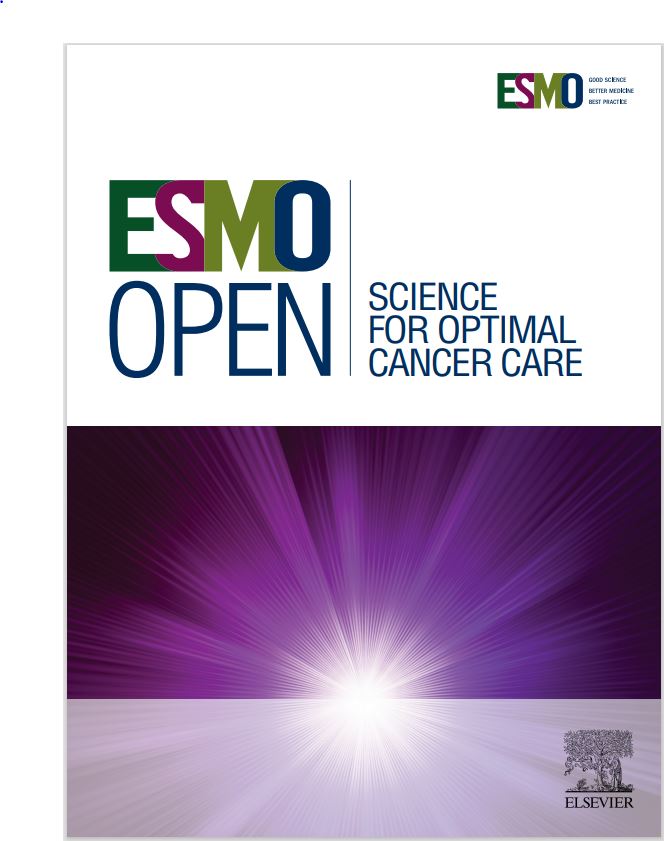Claudin 18.2:胆道肿瘤有希望的可操作靶点
IF 7.1
2区 医学
Q1 ONCOLOGY
引用次数: 0
摘要
背景与目的抗cldn18.2 (anti-CLDN18.2)疗法已被批准用于cldn18阳性胃和胃食管交界腺癌患者。目前的研究旨在评估CLDN18在一大组病理特征的胆道癌(btc)中的表达。材料与方法根据比特币协议收集237个btc。使用免疫组织化学(克隆43-14A)评估所有样本的CLDN18状态。如果≥75%的肿瘤细胞表现出中至强的膜性染色,则确定CLDN18的肿瘤阳性。结果cldn18在29.5%的btc(70/237)中表达,其中胆囊癌(GBC;62.5%;20/32)和肝外胆管癌(eCCA;53.4%;31/58),与肝内胆管癌(iCCA;12.9%;19/147) (P <;0.0001)。5.5%的病例(13/237)检测到CLDN18阳性,最常见于GBC (15.6%;5/32),其次是ecca (8.6%;5/58)和iCCAs (2.0%;3/147) (p = 0.0045)。大多数cldn18阳性样品(10/13)呈现异质染色模式。在iCCAs中,与小导管iCCAs相比,大导管亚型的CLDN18表达[33.3%(10/30)比7.7% (9/117),P = 0.0002]和阳性[6.7%(2/30)比0.9% (1/117),P = 0.106]高于小导管iCCAs。在GBC和eCCA组织类型中没有观察到显著差异,并且在icca中CLDN18与IDH1或FGFR2状态无关。结论本研究表明,CLDN18在btc的一个亚群中表达,在GBCs和eCCAs中的阳性率明显高于iCCAs。在iCCAs中,CLDN18在大导管亚型中表达更为频繁,但与IDH1或FGFR2状态无关。这些发现表明CLDN18可能是btc的潜在治疗靶点,需要进一步的前瞻性研究来评估其临床意义和对患者预后的影响。本文章由计算机程序翻译,如有差异,请以英文原文为准。
Claudin 18.2: a promising actionable target in biliary tract cancers
Background and purpose
Anti-claudin 18.2 (anti-CLDN18.2) therapy has been approved for patients with CLDN18-positive gastric and gastroesophageal junction adenocarcinomas. The current study aims at evaluating the expression of CLDN18 in a large cohort of pathologically characterized biliary tract cancers (BTCs).
Materials and methods
A series of 237 BTCs were collected and reviewed under the BITCOIN protocol. All samples were assessed for CLDN18 status using immunohistochemistry (clone 43-14A). Tumor positivity for CLDN18 was determined if ≥75% of tumor cells exhibited moderate-to-strong membranous staining.
Results
CLDN18 expression was found in 29.5% of BTCs (70/237), with the highest rates in gallbladder carcinoma (GBC; 62.5%; 20/32) and extrahepatic cholangiocarcinoma (eCCA; 53.4%; 31/58), compared with intrahepatic cholangiocarcinoma (iCCA; 12.9%; 19/147) (P < 0.0001). CLDN18 positivity was detected in 5.5% of cases (13/237), most common in GBC (15.6%; 5/32), followed by eCCAs (8.6%; 5/58) and iCCAs (2.0%; 3/147) (P = 0.0045). Most CLDN18-positive samples (10/13) exhibited a heterogenous staining pattern. In iCCAs, large duct subtypes had higher CLDN18 expression [33.3% (10/30) versus 7.7% (9/117), P = 0.0002] and positivity [6.7% (2/30) versus 0.9% (1/117), P = 0.106] than small duct iCCAs. No significant differences were observed across GBC and eCCA histotypes, and CLDN18 was not associated with IDH1 or FGFR2 status in iCCAs.
Conclusions
This study demonstrates that CLDN18 expression is present in a subset of BTCs, with significantly higher positivity rates in GBCs and eCCAs compared with iCCAs. In iCCAs, CLDN18 expression was more frequent in the large duct subtype but was not associated with IDH1 or FGFR2 status. These findings suggest that CLDN18 could be a potential therapeutic target in BTCs, warranting further prospective studies to evaluate its clinical significance and impact on patient outcomes.
求助全文
通过发布文献求助,成功后即可免费获取论文全文。
去求助
来源期刊

ESMO Open
Medicine-Oncology
CiteScore
11.70
自引率
2.70%
发文量
255
审稿时长
10 weeks
期刊介绍:
ESMO Open is the online-only, open access journal of the European Society for Medical Oncology (ESMO). It is a peer-reviewed publication dedicated to sharing high-quality medical research and educational materials from various fields of oncology. The journal specifically focuses on showcasing innovative clinical and translational cancer research.
ESMO Open aims to publish a wide range of research articles covering all aspects of oncology, including experimental studies, translational research, diagnostic advancements, and therapeutic approaches. The content of the journal includes original research articles, insightful reviews, thought-provoking editorials, and correspondence. Moreover, the journal warmly welcomes the submission of phase I trials and meta-analyses. It also showcases reviews from significant ESMO conferences and meetings, as well as publishes important position statements on behalf of ESMO.
Overall, ESMO Open offers a platform for scientists, clinicians, and researchers in the field of oncology to share their valuable insights and contribute to advancing the understanding and treatment of cancer. The journal serves as a source of up-to-date information and fosters collaboration within the oncology community.
 求助内容:
求助内容: 应助结果提醒方式:
应助结果提醒方式:


